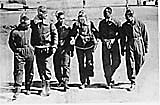
First Graduating Class of Tuskegee Institute
Tuskegee Airmen
"SMOKE" SCREEN EXPERIMENT
The Air Corps squadron would include thirty-three pilots and a ground crew of 250 men. $2 million dollars was given to two African American contract and architect firms. The NAACP accused the War Department "of maintaining the old army pattern of segregation, and said that the custom of segregation 'was the cause of most of the trouble experienced by African Americans in civilian as well as military life'" (Scott and Womack 148). The name 'smoke-screen' came from an editorial by Roy Wilkins, "to confuse and placate the Negro public while doing little training of Negro pilots" (149). The 99th Pursuit Squadron was activated on March 19, 1941. At the same time, the army instituted the Army General Classification Test. This was used to measure a soldiers learning ability. This test was biased in favor for those who have had more education and in the end, favoring white people. The Air Corp had the mass of black enlistments because the other branches were not accepting the quota for accepting African Americans. Most of the men had low AGCT scores and they were put in non-aviation roles such as "housekeeping, maintenance and labor chores" (151). The 99th Squadron was the only specialty squadron and many enlistees who had high test scores were put in other areas where their skills would be wasted because quota was already met. 278 of the 2,500 enlistees passed the examinations to the surprise of the Air Corp. Technical training occurred at Chanute Air Field (Tuskegee was not completed due the construction of segregated facilities), which consisted of armament, airplane mechanics and communications. There were white enlisted personnel as well but everything was still segregated. The Air Corps postponed training of the black pilots as long as they possibly could. Finally, thirteen men were picked with the requirements of not being over 26 years of age, married, over 6 feet tall or weigh more than 170 pounds. Capt. Benjamin O. Davis Jr.| The inaugural class of the thirteen flying cadets of the 99th Pursuit Squadron began its training at Tuskegee Institute on July 19, 1941. Their training consisted of preflight, primary flight training, basic military flight training and advanced military flight training. By the end of 1941, it seemed the Air Corps had no intention to use the men of the 99th Squadron except for cleaning military bases. After much debate in the political realm and after the attack on Pearl Harbor, Air Corps transferred the mechanics and specialists to Tuskegee and gave them rank. Five out of the thirteen members of the first class of flying cadets "washed out" before basic military flight training was over. From two graduations, the 99th Squadron had thirty-three pilots, administrative and medical crews, enough to be deployed as a combat unit. Many cadets who washed out had little options available to them as pilots. Many chose to fly for the Canadian Royal Air Force, some flying successful bombing missions in Europe. Many of the instructors were white, which intimidated many of the students. C. Alfred (Chief) Anderson
|
 First Graduating Class of Tuskegee Institute Tuskegee Airmen |